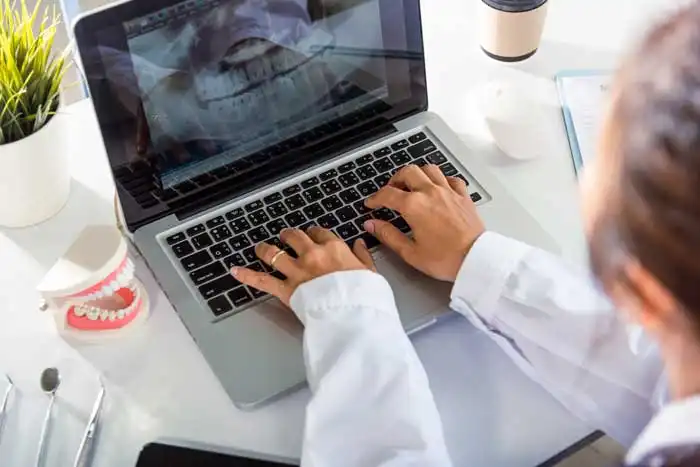2023/03/30
Dental Treatment Evolving with Digital Technology (Part 12)
The First Part: Interview with NTT DATA IOMC, ‘Verification Project on Medical and Dental Cooperation Using ICT’
Japan, AI (Machine Learning, Deep Learning), Clinical Doctor, Telemedicine, Examination and Diagnosis, Dentistry

What Technology is Required for Online Dental Treatment and Medical-Dental Collaboration?
You might think it is evident that oral health is essential. Still, dental and oral health has recently been taken up worldwide, with the phrase ‘dental and oral health is just as valuable as physical health’ being used to express the importance of dental health.
In November 2022, the World Health Organization (WHO) announced that 3.5 billion people, or about half of the population in the world, suffer from oral diseases such as tooth decay and gum disease. Around 380,000 people are newly diagnosed with oral cancer each year.
WHO Director-General Mr. Tedros states that oral health has been neglected in global health. It is preventable, and countries should integrate oral health into their primary health care models.’ 1)
One of the reasons why oral health seems to be neglected is the division between medicine and dentistry in terms of academic disciplines and insurance schemes. However, research has shown that the mouth is connected to the whole body and that oral health is related to systemic health.
For example, the Japan Diabetes Society’s ‘Scientific Evidence-based Diabetes Guidelines 2019’ states that diabetes and periodontal disease are mutual risk factors. 2) In addition, the well-known medical journal The New England Journal of Medicine (NEJM) grades following oral procedures as ‘To be considered’ under ‘Recommended’ in the appropriate clinical setting for preventing aspiration pneumonia. 3)
(1) Swallowing evaluation after stroke and after extubation from mechanical ventilation
(2) Oral care with brushing and removal of poorly maintained teeth
Thus, medical-dental cooperation is now a global challenge.

One of the reasons for the difficulties in medical-dental cooperation is the problem of access. For example, in Japan, the proportion of hospitals providing dental care could be higher, making it easier for patients in hospitals and nursing homes to receive dental care. Furthermore, the international medical journal LANCET has found that oral diseases are disproportionately suffered by the economically poor and socially disadvantaged, and that social factors of economic status and health are associated with the condition. 4)
ICT (Information and Communication Technology) is expected to help solve these problems. While online medical care is becoming widespread in medicine, the use of ICT in dentistry is being tested. For example, since 2020, ‘Verification Project for Medical and Dental Cooperation Using ICT’ has been conducted. The project has a committee of observers from universities, the Japan Dental Association, and the Ministry of Health, Labour and Welfare (MHLW) to examine how medical and dental cooperation and collaboration between other professions can be achieved using ICT. 5)

The MHLW commissioned this project to NTT DATA INSTITUTE OF MANAGEMENT CONSULTING, Inc. (hereafter referred to as NTT DATA IOMC). The project was implemented in cooperation with Medley, Inc., Medical Net, Inc., and iRidge, Inc. and completed its second year in March 2022.
This series of articles about the ‘Verification Project for Medical and Dental Cooperation Using ICT’ interviewing NTT DATA IOMC is divided into three parts.
We interviewed Mr. Dai Tomonaga, Associate Partner, and Ms. Yuko Hanawa, Manager, of the Life Value Creation Unit, NTT DATA IOMC.
Q1. Please tell us how the ‘Verification Project for Medical and Dental Cooperation Using ICT’ was set up.
Ms. Hanawa: It has been reported that the intervention of dentists and dental hygienists may reduce the number of days of hospitalisation of patients and elderly persons requiring care, decrease the incidence of pneumonia and other diseases associated with poor oral hygiene, and also lessen the risk of developing dementia and its progression. The needs for oral care, and the importance of cooperation between medicine and dentistry have been pointed out. For example, regarding medical costs, the item ‘management of oral hygiene’ has been evaluated in medical and nursing care reimbursement.
On the other hand, only about 20% of hospitals advocate dentistry, and there are few full-time dental specialists in long-term care facilities. Promoting oral management through the intervention of dental professionals and collaboration between care staff and dental professionals in the community is required.
Digital technology is rapidly being introduced in the medical and nursing care sectors. In medicine, promoting doctors’ work style reforms and COVID-19 has led to the introduction of online medical care. We have conducted this project intending to examine the possibilities of using ICT devices in dentistry and identifying issues.
Q2. Please tell us about your company’s involvement in the project.
Ms. Hanawa: As the trustee of the project, we planned and managed the entire demonstration and verification and conducted the following activities: universities, the Japan Dental Association, and established and launched a study committee of experts, including medical institutions, to examine the demonstration and verification content of this project. We also coordinated with the demonstration field (on-site), conducted verification, organised results, and issues, and prepared a report.

The first part of this article explains the background of the ‘Verification Project for Medical and Dental Cooperation Using ICT’ and provides an overview of the project’s activities. In the second part, I ask for more details.
(To be continued in the next issue)
【Source】
We have not received any rewards from the publishers for writing this manuscript.
The information contained in this article is compiled by the respective authors based on publicly available information. We assume no responsibility whatsoever for any damage or disadvantage caused by actions taken based on such information. Unauthorized reproduction of articles, photos, charts, etc. is prohibited.
Copyright © 2023 LSMIP office / CM Plus Corporation
A Series of Articles

